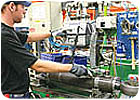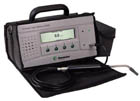
The demands placed on electronic leak testers can be summed up in four words: high, low, little and large. These systems need to have high sensitivity and low incidents of false positives or worse, missed leaks. They need to find little leaks, and must find these small leaks in large-as well as small-parts.
Leak testers used in a factory must be robust, safe, accurate and repeatable. Some modern leak testers are also being asked to gather data for statistical analysis and to make decisions based on selected parameters.
A new tester, the H2000, from Sensistor Technologies Inc. (N. Billerica, MA) uses the hydrogen method to fulfill all of these needs. It detects the leak, finds its location and determines the leak rate. The H2000 can be used in automatic and manual testing operations, and can be built so that it will act as a go/no-go station.
"The hydrogen method has been used since the 1980s," says Dave Morris, general manager of Sensistor Technologies. "What is different today, compared to earlier versions, is that we have stabilized a lot more on the electronic side, as most technologies have, so we can get better repeatability."

Finding Leaks
The best technique for leak detection is the one that fits the application-and the pocketbook. Parts are tested in many ways, from simple and relatively inexpensive tests such as the bubble test, to automated systems that use tracer gases such as hydrogen and helium. These cost more, but have a high sensitivity to leaks and can capture a wealth of data. The smallest leaks are often best found with tracer gases such as helium and hydrogen.Helium gas is one such gas that has been used effectively in many applications. However, says Morris, it must be used in tandem with a mass spectrometer, which is expensive to purchase and maintain, and is sensitive to environmental factors that could be found on a factory floor. It requires pumps and vacuums that may be vulnerable to dust and may result in higher maintenance costs. Helium is also a non-regenerative resource, and is more expensive than hydrogen, he says.

The Hydrogen Method
Hydrogen gas, or more accurately a mixture of 5% hydrogen and 95% nitrogen gases, has been used since the mid-1980s. Early in that decade, Sensistor Technologies' engineers (based in Sweden) began working on ways to overcome what is called the single biggest drawback in using hydrogen-flammability in high concentrations.The solution was to develop a stable detector with a sensor that was extremely responsive to hydrogen in low concentrations. In 1983 Sensistor Technologies co-founders, Dr. Claes Nylander and Fredrik Enquist, cracked the problem by designing a sensor that was specific and sensitive to hydrogen at 2.5 by 108 cubic centimeters per second (cc/sec) at atmospheric conditions. Likewise, they developed software and electronics to provide a stable and linear output signal for a display.
Diluted hydrogen is now considered a green-labeled gas; it is environmentally safe/nonflammable as per ISO 10156. It also meets with ISO 14000 for companies required to use renewable substances. It is the lightest and most viscous of gases and fills test objects quickly, which means that larger parts can be inspected.
The H2000 can be used as an automatic system or in a manual operation using the H50 hand probe. The hand probe is used to detect a leak location. It emits an audible signal when it senses hydrogen molecules and this tone grows in pitch as it nears the leak.

In a production line, a chamber test is used whereby the part is uploaded into the chamber, which is then flooded with hydrogen. The part is either ruled good, meaning that it has either no leaks or is within the leak limit, or bad, meaning that it is out of tolerance. Component size and leak size may affect cycle times, but in general these tests can be completed in 1 to 30 seconds.
"In an automatic system, a chamber test would be conducted. In that case, you are looking for the total leakage. You are not trying to locate the leak, you are just asking the question, ‘does it leak?' and ‘what is the overall leakage of the part?' and that you can do by putting the part into the chamber."
The H2000 requires no pumps or vacuums, which Morris says eliminates the need for any "real" maintenance. "The detector requires nothing more than changing a sensor every 2 or 3 years and that can be done in less than a minute," he adds.
Many users are choosing to integrate pressure-decay/mass flow with hydrogen test systems, says Morris. "An example of this might be a car engine assembly," he adds. "The manufacturer wants to know if the whole product is tight or not. If it fails the test, operators must locate where the leak is so it can be fixed on line. One way of doing that is to combine the pressure-decay/mass flow test and the hydrogen method test. If the part is tested using the pressure decay method, the user can backfill it with the hydrogen nitrogen mixture and then use a probe to go around suspect points to find the leak position."
Technology Contact
For more information on the H2000 leak tester, contact:Sensistor Technologies Inc.
267 Boston Rd., Suite 3
N. Billerica, MA 01862
(978) 439-9200
E-mail: [email protected]
URL: www.sensistorusa.com
Sidebar: Quality Specs
- The hydrogen method uses a mixture of 5% hydrogen and 95% nitrogen.
- Test parts can be quickly filled and purged for production line use.
- The tester can be configured in an automatic system or used with a handheld probe.
Sidebar: Hydrogen Sensor Working Principles
Sensistor hydrogen leak detectors work on the principles of microelectronic sensor technology. The gas does not need to be transported into the detector instrument. Instead there is a small microelectronic chip mounted in a sensor housing, either in a hand probe, or in an insert probe used in automatic testing equipment. The sensor technology allows a lot of flexibility, which is not the case for traditional leak detectors.The hydrogen sensor is a unique type of gas sensor, which is sensitive to hydrogen and totally insensitive to almost all other substances. While other hydrogen gas sensors (thermal, catalytic) used in hydrogen gas alarm equipment are normally sensitive to a lot of other gases and vapors, the Sensistor sensor in not affected by common interference such as methane, propane, gasoline vapors, water vapors or organic solvent vapors.
The sensor consists of an integrated circuit containing a MOS-FET amplifier. Instead of an electrical input to the amplifier, there is a thin film of metal hydride, which is permeable to hydrogen atoms only. Hydrogen molecules (each consisting of two hydrogen atoms) split into atoms when hitting the metal surface, and are selectively absorbed by the film. The absorbed hydrogen atoms give rise to a small voltage, which is amplified and transferred to the detector instrument. The instrument carefully controls the temperature of the sensor chip and interprets the sensor signals. The sensor voltage is not a simple function of the gas concentration. Therefore there is some signal processing in the instrument to compensate for background, drift and other factors, and to determine the hydrogen concentration in a gas sample.
Source: Edited from Hydrogen Sensor Working Principles by Sensistor Technologies.